
|

|
|
Home Site Search Contact Us Subscribe
|
|
|
INSIGHT: Small-Scale Solution to Alternative Energy Resistance Why the assumption that an industrial-scale response is required to produce green energy in the vast quantities required to power this country is wrong. By Peter Gisolfi, AIA, ASLA, LEED AP September 27, 2011 Articles about wind and solar energy are constantly in the news. Recently, we read that Germany has plans to close its nuclear generating plants in favor of alternative sources, with the enthusiastic backing of its citizens. And yet, in the United States, we have been reluctant to give up our reliance on conventional fuels.
Construction of large-scale wind farms is a concept actively resisted here. Critics claim that property values will decline and tourism will be significantly harmed where acres of wind turbines are visible. Production costs are too high, they say. And large concentrations of wind turbines produce noise and currents that might adversely affect the ecosystem, even if we cannot precisely predict those effects at this point.
The other commonly mentioned alternative source is solar energy – large-scale arrays of photovoltaic collectors. This solution also has its detractors. Critics assert that the equipment is too costly, and that pollution can degrade the efficiency of the panels. They also point out that clouds impede their effectiveness.
The error in this thinking is the assumption that an industrial-scale response is required to produce green energy in the vast quantities required to power this country. That premise is wrong. The problem does not have to be addressed on massive acreage or with gigantic photovoltaic installations cluttering the landscape. Nor do we necessarily have to incur the transmission losses that would result from large-scale renewable energy plants. Instead, the solution can be achieved on a small scale on countless individual sites.
Looking at energy consumption statistics, it is clear that the building sector is our biggest energy user – and the most profligate energy waster. Transportation consumes approximately 27% of our energy – 88% of that figure is attributed to gasoline and diesel fuel for trucks and cars. And yet, with reasonable effort, energy-efficient vehicles will reduce energy consumption in this sector by 50%. Industry uses about 30-33% of our energy, and I believe, estimating conservatively, we could cut energy consumption in the industrial sector by one third. The remaining 40-43% of our total energy use is consumed by buildings.
Our first task in the building sector is to turn our existing buildings into Thermos bottles – tightly constructed, well insulated buildings that prevent heat loss in the colder months and heat gain in the summer. This solution could easily reduce energy consumption in the building sector by 50%. Then, by updating existing mechanical systems to more efficient systems using conventional fuel, or with site-based systems, such as geothermal heating and cooling, non-intrusive photovoltaic solar collectors, or small-scale wind energy projects, we could reduce energy consumption in the building sector by as much as 75% – with no adverse aesthetic, economic, or environmental effects.
With these projections in mind, the picture changes dramatically. The transportation sector can reduce its energy use from 27% to 13.5% of our total current energy consumption; the approximately 31.5% of our energy that is used by industry can be reduced by a third to become 22%; and the building sector’s energy consumption – our worst offender – can be reduced from about 41.5% to an astonishing 10.5%. The result of these projections is that future energy use would equal only 45% of the energy currently consumed in the United States.
It is encouraging to look even further ahead. Hypothetically, as more and more individual sites produce excess electricity, the electric power grid would become a trading grid in which energy users buy electricity from utility companies and also sell electricity back to the same companies. Utilities would both generate and trade electricity. Conceivably, within the next 10 to 15 years, we would have vast surplus capacity in our electric utilities, and we could then think more gradually about what might be the green fuel for generating electricity on a large scale in the future. The concept is exciting, achievable, and a revolutionary departure from today’s heavy reliance on conventional fuels.
All of this, of course, requires a reasoned discussion and the political will to make effective change.
About the author: Peter Gisolfi, AIA, ASLA, LEED AP, is chairman of the Spitzer School of Architecture at the City College of New York, and author of the book, Finding the Place of Architecture in the Landscape. He is senior partner of Peter Gisolfi Associates, a firm of architects and landscape architects in Hastings-On-Hudson, NY, and New Haven, CT. He can be reached at pgisolfi@petergisolfiassociates.com.
Also by Gisolfi: INSIGHT:
Collaboration and Compromise: A Misunderstood Aspect of the Design Process
INSIGHT: Save What's
Left: Architects as Stewards of Our Planet |
(click on pictures to enlarge)  Robert Mintzes Detail of the Student Center at Manhattanville College in Purchase, NY, with solar collectors on the roof. Peter Gisolfi, architect for the project, says that 15 percent of the electrical energy for the building is supplied by the sun, while the building itself consumes approximately 50 percent less energy than a typical code-compliant building. |
© 2011 ArchNewsNow.com